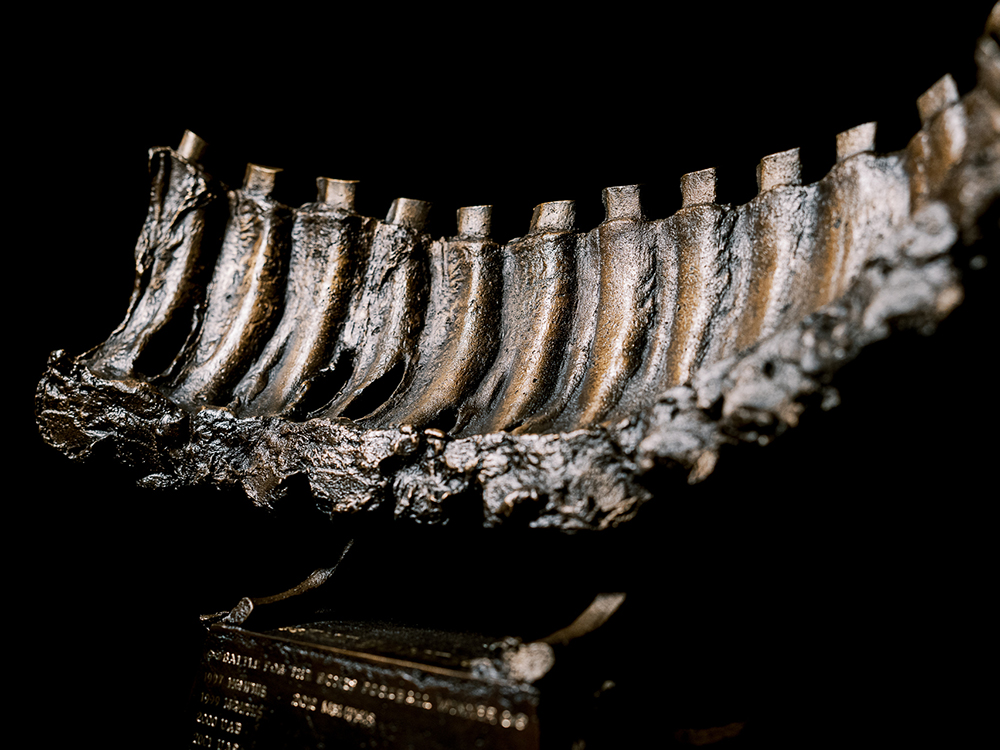
UAB and Memphis are about to rekindle the hungriest rivalry in college football. On Oct. 21, the Memphis Tigers return to Birmingham for the schools’ first football meeting since 2012. In 2013, the Tigers left Conference USA for the American Athletic Conference, ending the football game and mothballing one of the most talked-about rivalry trophies of the time: the Bones, aka “the ribs trophy,” a 100-pound, 2-foot-by-2-foot behemoth. Now, as UAB plays its first season as a member of the American Conference, the Bones are back. So is the traditional barbecue contest before the game, whose winners are also immortalized on the base of the Bones.
Let’s be honest up front: The Bones were always a marketing stunt. And a very successful marketing stunt at that. Once you have seen the Bones, you will not forget. In 2021, when UAB announced that it was joining the American Athletic Conference and the Memphis series would be rekindled, a Washington Post columnist wrote: “Finally, something good comes out of conference realignment: The ribs trophy is coming back.” Search on Twitter and you will find many posts labeling it “the coolest trophy in all of college football” and other superlatives.
?????? ??? ??? ????? ?
— UAB Football (@UAB_FB) November 9, 2022
Returning annually, beginning 2023 in Birmingham!#WinAsOne pic.twitter.com/6Ni1JbMsdz
Ever since the final Battle for the Bones game in 2012, the ribs trophy has been in Memphis. But its creator has already had it back in Birmingham this summer on loan, for photo shoots around the renewed Battle for the Bones BBQ Competition, an integral part of the rivalry game weekend. And he is looking forward to its taking up residence in a UAB trophy case as of Oct. 21.
We go way back
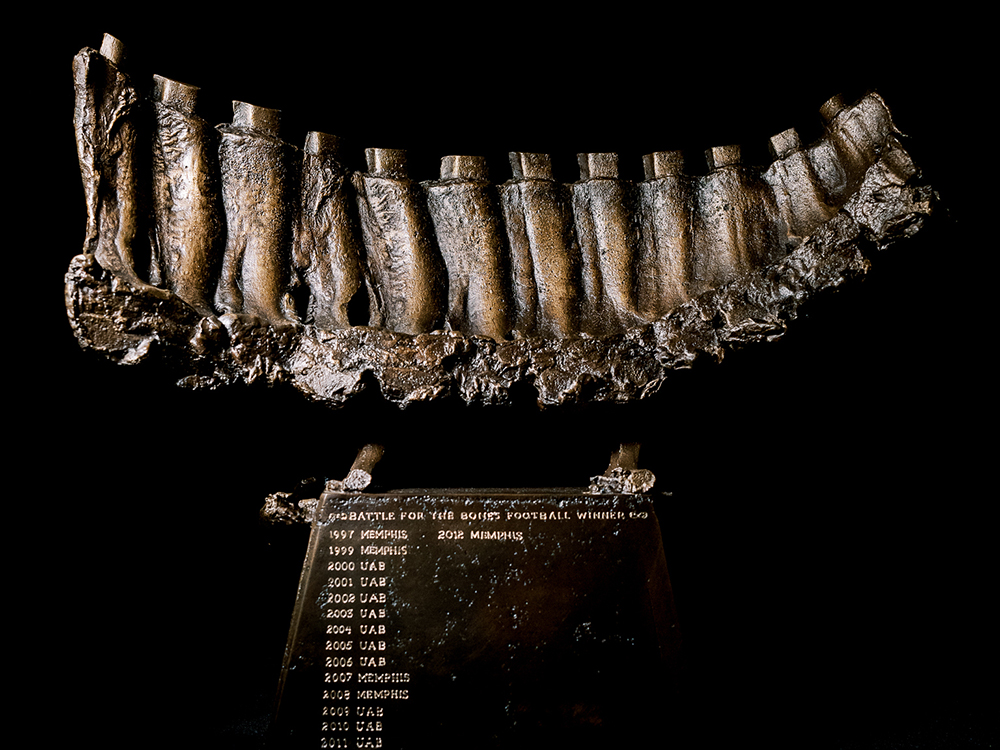
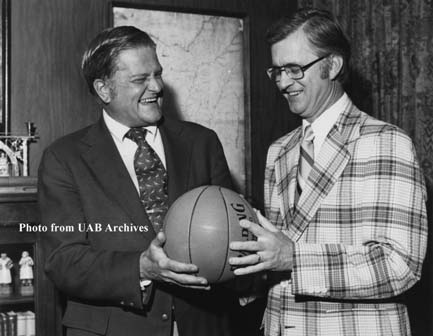 President S. Richardson Hill, Jr., welcomes Gene Bartow (right) to UAB as the university's first athletic director and head coach of a new men's intercollegiate basketball team, June 14, 1977, in this photo from UAB Archives. Bartow served as coach until 1996 and as athletic director until 2000.
President S. Richardson Hill, Jr., welcomes Gene Bartow (right) to UAB as the university's first athletic director and head coach of a new men's intercollegiate basketball team, June 14, 1977, in this photo from UAB Archives. Bartow served as coach until 1996 and as athletic director until 2000.
UAB and Memphis have a history. When legendary basketball coach Gene Bartow arrived in Birmingham in 1978, recruited from big-time UCLA, he had already demonstrated small-school magic by taking what was then Memphis State University to the NCAA basketball tournament championship game in 1973. (This Sports Illustrated article from 1978 proclaimed that "with former UCLA coach Gene Bartow, brash Birmingham is starting at the top.") In 1984, with Bartow as coach, UAB met Memphis on the basketball court for the first time. Each year, the schools and their fans had these matchups circled on their calendars before the season began.
UAB and Memphis had their inaugural football clash in 1997; but without the shared father figure in Gene Bartow, the gridiron rivalry did not have the same energy. “We had this very intense but friendly rivalry between the two schools,” said Sam Miller, owner of Champ Creative Co. in Birmingham and former associate athletic director for Athletic Marketing with UAB. “We were selling out basketball games. Our job was to bring as much relevance to UAB Football as possible, and we wanted to tap into all the fun that can exist with rivalries in college football.”
A UAB alumnus had an idea: Each city has a rich barbecue tradition — why not have a barbecue contest between Birmingham and Memphis? “As that idea evolved, we said, ‘Let’s really go all in and try to create the most unique trophy in all of sports,’” Miller said. “‘We’ll tie it into a barbecue contest and the cities’ barbecue tradition.’” (UAB students will have a chance to learn about that tradition, and eat at some of Birmingham’s legendary barbecue restaurants, with a new course coming in spring 2024. See “Barbecue history,” below.)
There was just one problem: “I did not know the first thing about barbecue, other than I like to eat it,” Miller said. “Starting from absolute scratch to put together a barbecue contest that we wanted to be a major event was certainly a learning curve.”
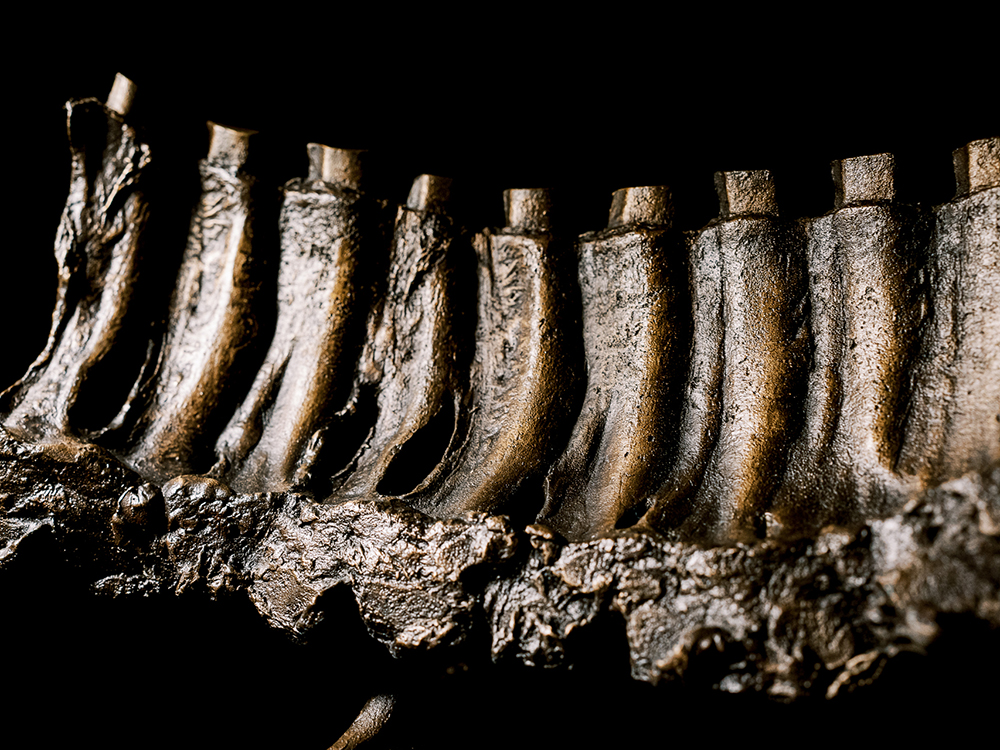
“This beautiful, gross, stinking Frankenstein”
Then there was the trophy. “We set out to make something outlandish, but in a very fun way that would bring some character to the game and get a lot of attention outside Birmingham and Memphis,” Miller said. The rough idea came quickly. Then it was just a matter of “figuring out how to build a 2-foot-wide rack of ribs that would be so heavy that an entire offensive line would struggle to pick it up together,” he said.
Luckily, Miller had a contact in the trophy business. Sort of. “My husband is in [video] production in town and used to work with Sam on a lot of the football commercials,” said Heather Spencer Holmes, then a metal artist working at Birmingham’s Sloss Furnaces and now the art studio lab supervisor for the UAB Department of Art and Art History. (And still a metal artist.) “Sam said, ‘We want a giant rack of ribs as a trophy.’”
“I said, ‘This will be the weirdest phone call you will have all day, I guarantee it,’” Miller recalled. “She laughed out loud and said, ‘Let’s try!’”
Casting art, or a trophy — in bronze, as Miller specified — usually requires a mold. “But it’s really hard to find a full set of ribs as large as he wanted,” Holmes said.
“It can’t be a rack of ribs like you would get at Piggly Wiggly,” Miller said. “It had to be this giant thing. We kept pushing and pushing to make it as big as possible, but we had to have an actual sculpture to build the trophy from. We wound up at Southeastern Meats in Bessemer, toothpicking together multiple racks to make the gigantic ribs that are in the trophy now. Then we took this beautiful, gross, stinking Frankenstein to Heather and she made the cast and poured it.”
“I made plaster molds of the raw meat, which is pretty gross,” Holmes confirmed. “I still wasn’t sure of what it was going to look like, but once I made the molds, then I made wax replicas of the meat and I could play around with how big they needed to be and figure out the base. Then I got the brilliant idea to make molds of some clean bones and use those for handles and the support for the trophy.”
The metal pour happened at Sloss, part of an overall process that lasted “two hard-core weeks,” Holmes estimated. “The base was actually wood — once everything was assembled, I made a sand mold and then I was able to pull the wooden box out and I had the imprint of it and the mold went into a kiln and we melted all the wax out, reassembled the mold and we had a hollow form for the trophy.” (Learn more about Holmes and her role in other Birmingham and UAB landmarks below.)
Hollow does not mean light. “When we came back and saw the reveal, it was amazing,” Miller said. “We thought it was going to weigh 30 or 40 pounds; but when we tried to pick it up, it was close to 100. That absolutely adds to the lore of the trophy.”
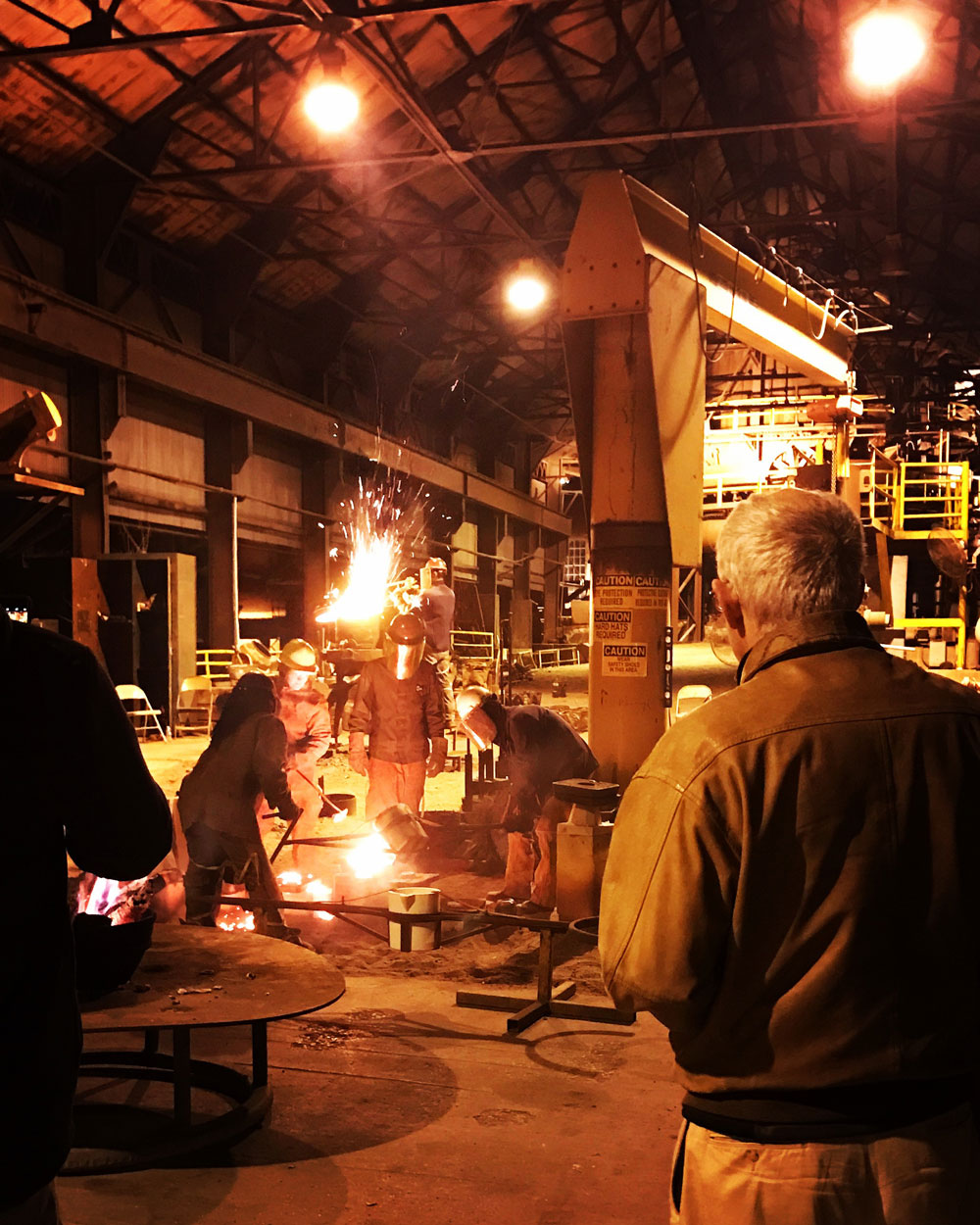 An iron pour at Sloss. Photo courtesy Heather Holmes
An iron pour at Sloss. Photo courtesy Heather Holmes
A one-sided rivalry: “We just did it anyway”
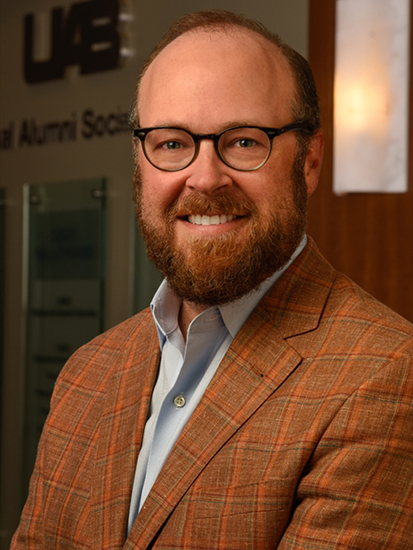 Sam Miller, who earned his MBA at UAB in 2003, is serving as president of the UAB National Alumni Society as of Oct. 1, 2023. (NAS photo from a previous stint on the board for Miller in 2017.)After he had the trophy and the barbecue contest (more on that below) lined up, Miller reached out to his counterparts at Memphis. “We kind of ran before we walked with this,” Miller admitted today. “We were just operating on the assumption that of course they would want to play along and be a part of it. But Memphis declined to participate, although they were polite about it. So we just did it anyway.”
Sam Miller, who earned his MBA at UAB in 2003, is serving as president of the UAB National Alumni Society as of Oct. 1, 2023. (NAS photo from a previous stint on the board for Miller in 2017.)After he had the trophy and the barbecue contest (more on that below) lined up, Miller reached out to his counterparts at Memphis. “We kind of ran before we walked with this,” Miller admitted today. “We were just operating on the assumption that of course they would want to play along and be a part of it. But Memphis declined to participate, although they were polite about it. So we just did it anyway.”
Before the game, UAB paraded the trophy around the stadium. “We made it a show to force the idea it was going to happen,” Miller said. “We had it outside the end zone and had the UAB ROTC guard it. I had this fear throughout the whole game that, if we didn’t win that trophy, it might still be sitting there the next morning. But we did win, and the team ran over and grabbed it and it was exciting.”
It was much heavier than they expected, though. “I’ll never forget the look on the center’s face when he went to pick it up,” said Holmes, who was there as Miller’s guest. “It took several of them to get it.”
This was 2006, remember, so there was no social media to spread the news. “It went viral the old-fashioned way,” Miller said. “Once photos of it began to leak out over the weekend, it really did start getting a lot of attention as this quirky new tradition, and I wound up getting interview requests from college football towns around the country. It was a big deal; I got a call from USA Today to talk about it.”
Miller, who still works on ad campaigns with UAB Athletics, also teaches a class in sports marketing at the Collat School of Business. “I know a thing or two about that,” he said. “I was really out on a limb with the trophy; but Watson Brown, who was the football coach and athletic director at the time, said, ‘If you say it will work, I will do it.’”
(One of Miller's videos for UAB Football is below.)
Birmingham, Memphis and BBQ
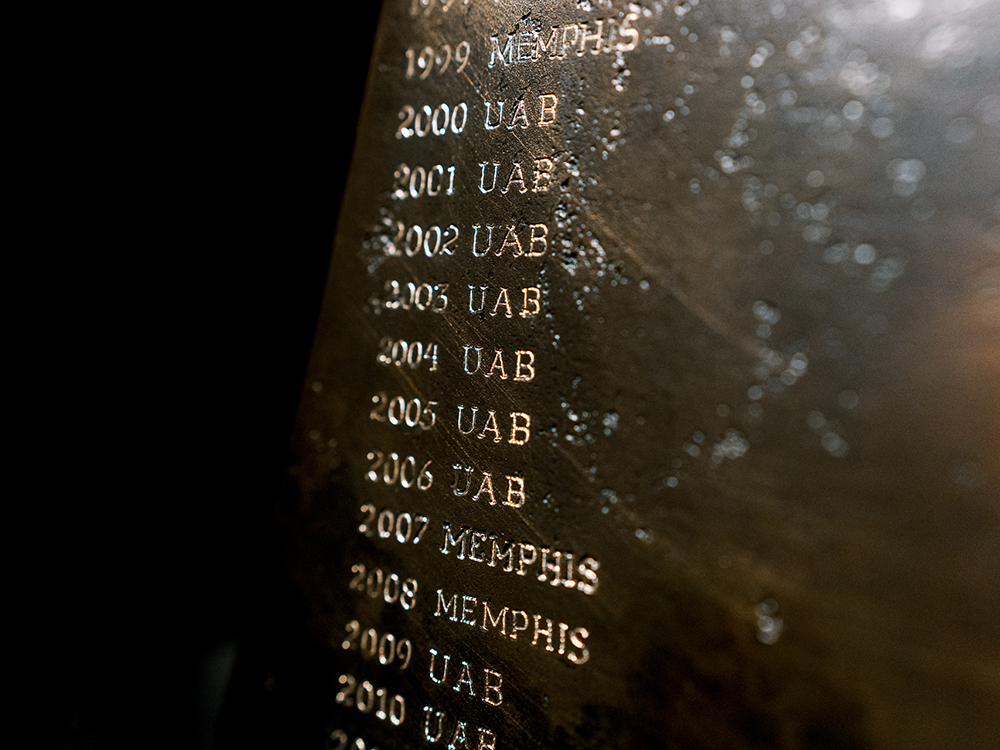
On one side of its base, the Bones trophy lists the football results. (UAB leads 4-3 going into the 2023 rivalry renewal game.) On the other are the results of Miller’s other project in 2006: the Battle for the Bones BBQ Competition. To make things even better, teams from Birmingham won the professional and amateur barbecue competitions in that first year as well.
The point of the Bones trophy and associated events was always to attract attention to UAB and Birmingham, and on that count it is still succeeding. When the Washington Post wrote about UAB’s move to the American Athletic Conference, the columnist mentioned “Birmingham’s and Memphis’ status as two of the United States’ premier barbecue hubs.”
Miller’s dream led to the first and only giant set of ribs that Holmes has made, and she has done nothing like “that glorious, bizarro project” since, she said. But it was not her first barbecue trophy. “Sloss used to have its own barbecue festival, so we as resident artists made trophies,” Holmes said. “We had a summer youth student who made a wax replica of one of the furnaces, so we would cast those for the Sloss barbecue trophies.”
That is where another UAB voice in the story comes in. Chris Savage, DNP, a certified registered nurse anesthetist at UAB Hospital, is a three-time alumnus as well, earning his bachelor’s degree in nursing in 1997, his nurse anesthetist master’s degree in 2004 and his Doctor of Nursing Practice degree in 2016. “Back in the early 2000s, there used to be this big barbecue contest at Sloss Furnaces,” Savage said. “I went one year as a spectator, and the next year my brother and I entered as a team. We have been competing since 2010 and won a couple of local contests.” Their name: Savage Brothers Barbecue.
Barbecue contests are great fun, Savage says. But being a pitmaster — that is the preferred term — “is a tough business,” he added. “I’ve got a wife and two kids; I’m not going to quit my day job.” He paused, as if allowing himself to dream: “Maybe post-retirement.”
Savage Brothers entered the Battle for the Bones BBQ Competition — the one Miller and team started in 2006 — several times. “The best we did was fourth,” Savage said. “We always liked it and had fun. Barbecue and football, what’s not to like?”
Winning the Battle for the Bones BBQ title, like picking up the Bones themselves, is a heavy lift. “We first thought we would get all the restaurants in Memphis and Birmingham to come together,” Miller said. “A bunch said they would bring their trailers and cook, and we thought that this would attract people to Legion Field to come and taste this incredible variety of barbecue. But we quickly learned that the people who do this professionally and go to tournaments are in an entirely different league when it comes to really specializing in this. The way they showed up to spend a couple of days preparing and having fun was really something to see, and that changed how we did things going forward.”
The UAB team put a lot into the barbecue contest, Miller says. “We had really competitive prize money, and we wanted this to be something that would attract the best teams,” he said. “By the second time we had it in Birmingham, we had teams from Memphis and Alabama, but also people coming from across the Southeast who didn’t have ties to either school.”
The first year, in 2006, a total of 16 teams entered the contest, Miller said. “The most we ever had at Legion Field was in the high 30s. It took a little time to grow; it was helped when Memphis hosted the game for the first time and they put the tournament on. That city is such a hotbed for people who participate in barbecue contests.”
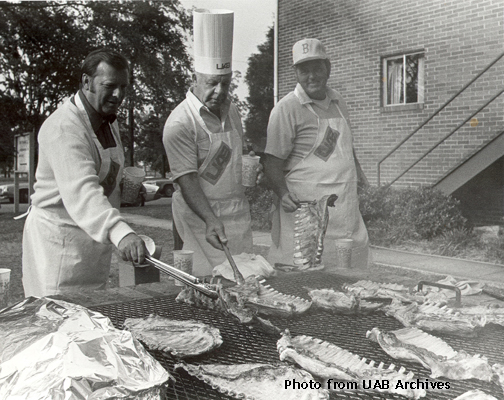 UAB is no stranger to ribs. In this photo from UAB Archives, circa 1980, Dr. Jerry D. Young, vice president for Finance; Ray Boothe, head of UAB facilities; and Stanley L. Chesser, director of Campus Services and Grounds, prepare the day's meal for a university office picnic. The barbecue pit was located on the western edge of campus near South 11th Street and adjacent to the Special Studies and Facilities Management buildings.The Battle for the Bones has always been a single-meat contest: ribs, just like the trophy. Barbecue contests often include four meat categories: brisket, pork, ribs and chicken. Savage shows his preference in his custom license plate: BRISKET. “I usually do the brisket and ribs and my brother does the chicken and pork,” he said. “A typical contest that takes place on a Saturday, you can show up Friday evening and set up. That’s usually when they do meat inspection; you can’t do anything ahead of time. The judges make sure it is in a Cryopak and that you are following good health code guidelines.”
UAB is no stranger to ribs. In this photo from UAB Archives, circa 1980, Dr. Jerry D. Young, vice president for Finance; Ray Boothe, head of UAB facilities; and Stanley L. Chesser, director of Campus Services and Grounds, prepare the day's meal for a university office picnic. The barbecue pit was located on the western edge of campus near South 11th Street and adjacent to the Special Studies and Facilities Management buildings.The Battle for the Bones has always been a single-meat contest: ribs, just like the trophy. Barbecue contests often include four meat categories: brisket, pork, ribs and chicken. Savage shows his preference in his custom license plate: BRISKET. “I usually do the brisket and ribs and my brother does the chicken and pork,” he said. “A typical contest that takes place on a Saturday, you can show up Friday evening and set up. That’s usually when they do meat inspection; you can’t do anything ahead of time. The judges make sure it is in a Cryopak and that you are following good health code guidelines.”
Long-cooking cuts such as brisket, which is usually in the smoker for 12 to 14 hours, often gets started the night before. “Low and slow is what we follow,” Savage said. He uses a horizontal smoker with wood logs and a firebox on the side, what is known as a stick burner. He favors hickory and pecan, “mostly because they are easy to get here,” he said.
Miller’s experience as the host of a barbecue contest got him into the pitmaster game as well. “Like most people at UAB, I am partial to Full Moon Barbecue,” he said. (Savage agrees.) “But my favorite now is what I cook myself,” Miller said. “The first time that I ever had real craft barbecue was at Legion Field during the first contest. One of those guys waved me over and said, ‘I want you to try this.’ It blew my mind. I was at Lowe’s the next day buying a smoker grill and teaching myself.” His favorites are pork shoulder and babyback ribs.
Has Miller entered any contests? “I have always wanted to, but I haven’t had the time yet,” he said. “I have catered a few parties. I already have my barbecue team name, though: Green Egg and Sam.”
Time has also caught up with Savage. Although he still competes in barbecue contests, his family obligations mean he has had to cut back. “Unfortunately, my kids have a soccer game and a volleyball match that Saturday,” so he will not be entering the Battle for the Bones BBQ Competition this year, Savage said. “I am hoping that in two years, when it is back in Birmingham, I’ll have a chance to enter.”
Miller is looking forward to the return of the barbecue competition as well. “It very quickly became an event that everybody looked forward to each year, including the folks at Memphis, who fully dove in,” he said. “I’m excited that it’s back.”
Safety first
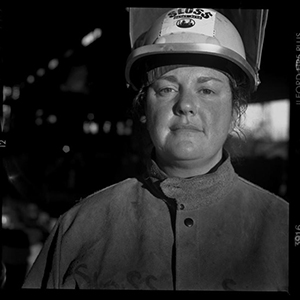 Artist photo, courtesy of Heather HolmesHeather Holmes began her journey to metal arts mastery as a UAB student “many, many years ago,” she said. “I hadn’t lived in town long and I wanted to continue taking art classes, which I did at UAB. I started picking up shiny pieces of metal in the street. I decided I wanted to learn a trade, and since I had all these pieces of metal, I thought I would learn welding.” She enrolled in one class at Birmingham’s Lawson State Community College, “but my instructor was so persuasive that I ended up in classes from 8 to 3 five days a week,” she said. “Then I got a scholarship as a female in a non-traditional profession and the rest of my two years in the program was free.”
Artist photo, courtesy of Heather HolmesHeather Holmes began her journey to metal arts mastery as a UAB student “many, many years ago,” she said. “I hadn’t lived in town long and I wanted to continue taking art classes, which I did at UAB. I started picking up shiny pieces of metal in the street. I decided I wanted to learn a trade, and since I had all these pieces of metal, I thought I would learn welding.” She enrolled in one class at Birmingham’s Lawson State Community College, “but my instructor was so persuasive that I ended up in classes from 8 to 3 five days a week,” she said. “Then I got a scholarship as a female in a non-traditional profession and the rest of my two years in the program was free.”
Her instructor suggested that she head over to Sloss Furnaces to help out a visiting group of artists that included experts from Florida State University. “The first time I saw molten metal flow out of a cupola, I said, ‘I have found my people. This is amazing,’” Holmes recalled. Soon enough, she was teaching workshops, started a metal furniture business and began to teach blacksmithing as well. In the 1990s, she was employed at Brad Morton Studio, which created the 20-foot-tall “Encounters” statues on UAB’s campus and the “Sisters Vigil” statues at St. Vincent’s Hospital, among other artworks nationwide. “I also worked on the Frank Fleming sculpture at the Alys Stephens Center,” Holmes said. (This intricate, towering sculpture, called “The Performers,” is in the middle of the ASC’s lobbies. Fleming also created “The Storyteller” fountain in Five Points.) Holmes and UAB alumnus Forrest Millsap created MESH Collective Art, which made “a giant double-sided Lite-Brite, and a fire machine” for the Light Dreams events at the Alys Stephens Center in 2013 and 2014. The MESH Collective “also built the giant pair of safety glasses” now on display at Red Mountain Park “in the sculpture courtyard at Hulsey,” Holmes added.
Each year, the Sloss team heads to the famous Kentuck Festival of the Arts in Northport, Alabama, with a portable furnace to do an iron pour. “It is beautiful; but it can be dangerous, mixing molten metal and the general public,” Holmes said. “Being trained by doing those sorts of events made me perfect for the job I do now.”
For the past eight years, Holmes has been the art studio lab supervisor at her alma mater. “I handle all health and safety aspects of the department,” she said. “I assist with training and make sure that all safety protocols are observed and that all machinery is working properly.” The Department of Art and Art History has studios in three buildings — Humanities, AEIVA and the Hulsey Building — “which keeps things interesting,” Holmes said. The biggest project currently is moving six of the department’s eight studios to the 501 Building near Bartow Arena. “The new space is awesome,” Holmes said. “And I am good at planning things, so that works out well.”
One of the best parts of her job is that “I still get paid to learn,” Holmes said. “The department sent me to a 30-hour OSHA compliance course several years ago and that has been very helpful. And I have learned how important it is to have good relationships with the Environmental Health and Safety department. Say you have a student who has glued a bunch of pills to a canvas and wants to show the work in the gallery. I call them up and say, ‘They are supposed to be all over-the-counter pills, nothing prescription; but what if a pill falls off and someone picks it up? Should we put something over the canvas, or under the frame?’ Those are fun, interesting conversations.”
Holmes is always creating. Recently, she participated in a workshop where “I made a 3-foot cast-iron sculpture piece,” she said. “The mold was probably 1,500 pounds per side. That was exciting, being able to work big again.”
Barbecue history
One of the signature elements of UAB’s new Blazer Core Curriculum, launched in fall 2023, is its City as Classroom courses, which build on the university’s tradition of working directly with local communities. In the spring 2024 semester, Jenna Reynolds will debut a course called Eating in Birmingham: From Food Banks to Fine Dining, which will take students through the city’s celebrated food scene.
Want to make the city your classroom? Start your UAB journey here.
Reynolds, an instructor in the Department of World Languages and Literatures, says the class will spend a fortnight on barbecue, including several restaurants that are original to Birmingham, including Full Moon BBQ (started in UAB’s own Southside neighborhood), Magnolia BBQ and Fish, and Saw’s Kitchen. “The theme for these two weeks when we will discuss barbecue is ‘Africa and the African Diaspora,’ so this course centers the role of African American knowledge and tradition around the theme of barbecue,” Reynolds said. Class readings will present the history of the cooking style known as “barbacoa” and “its indigenous origin in the Americas and Alabama specifically,” Reynolds explained. “We will also discuss chapters of Jessica B. Harris’ text ‘High on the Hog: A Culinary Journey from Africa to America,’ most specifically those chapters that discuss the Africanizing of the Southern palate and the role of the African diaspora in what we consider barbecue today.”
Students also will watch documentaries about the Alabama barbecue masters Roscoe Hill and Rodney Scott, founder of Rodney Scott’s BBQ restaurants. “I plan to include a restaurant visit to one of his Birmingham locations in this course,” Reynolds added.
Read more about “Eating in Birmingham” and see other City as Classroom courses in the UAB undergraduate catalog.